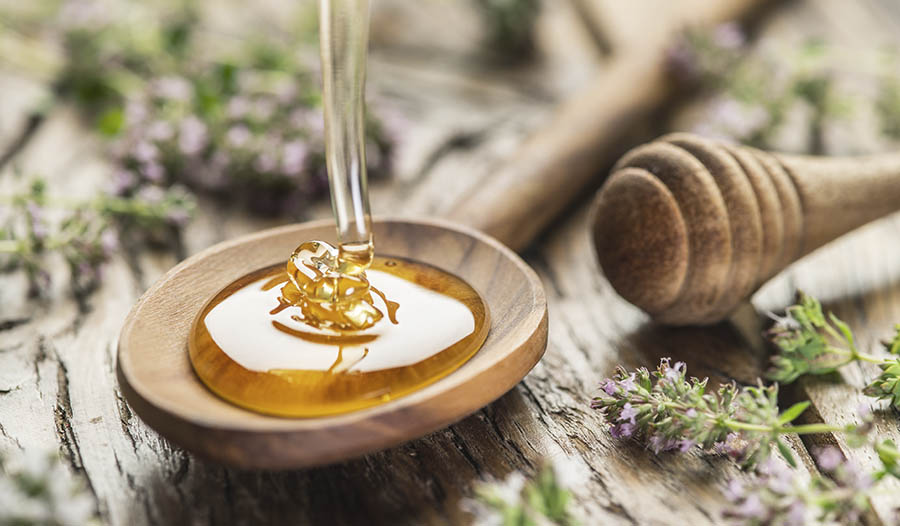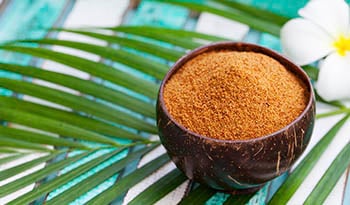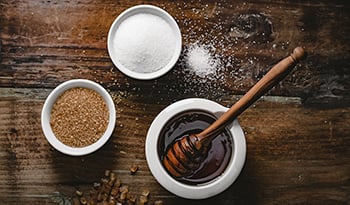7 Best Healthy Sweetener Alternatives—From Stevia to Monk Fruit
DISCLAIMER:This blog does not intend to provide diagnosis...
- In this article:
- What is Sugar?
- Where Does Added Sugar Come From?
- Types of Sugar
- 7 Best Healthy Sweetener Alternatives
- Recommendations for Sugar Intake
- Ways to Reduce Added Sugar Intake
- Takeaway

Originally Posted October 2017 | Updated September 2022
Do you love sweets? Me too! Sugar is often misunderstood. And contrary to what many believe, sugar isn’t always “bad.”
Sugar is in many foods—including the ones you’d expect, like cookies and soft drinks, as well as ones that might surprise you, like bread and even potatoes. While certain foods, like fruits and juices, contain sugar naturally, added sugars are added during the processing of foods.
We need sugar, or more specifically, we need glucose to fuel our bodies. Though we don’t need added sugars to function, they add a sweet, fun element to our lives. There are many healthy alternatives to sweetening your food in place of sugar, but first, let's start with the basics.
What is Sugar?
Sugar is a type of carbohydrate made of molecules called saccharides. All kinds of sugar are eventually broken down into glucose, the sugar our bodies use for fuel.
There are two categories of sugar—natural and added. Natural sugars are found in fruits and vegetables and are unprocessed. Added sugars are put into foods by manufacturers to make them taste better. Foods containing these two types of sugars can be classified as simple or complex carbohydrates, depending on how fast your body digests and absorbs them.
- Simple carbohydrates, such as refined sugar, candy, and white bread, are digested quickly and used right away.
- Complex carbohydrates, including whole grains like brown rice and quinoa, fruits, and some vegetables, take longer to digest and provide long-lasting energy.
The glycemic index (GI) is a tool used to measure how quickly a food raises blood sugar levels. Typically, foods with simple carbohydrates tend to have a higher GI, while foods with more complex carbohydrates have a lower GI.
Understanding the different types of sugar and how they affect your body can be complicated, but it is essential for maintaining your health. The average American consumes about 17 teaspoons of sugar every day.1 This isn’t hard to believe when there are over 56 different names for sugar out there! Sweeteners added to foods fall into one of four categories — naturally occurring, refined, artificial, and sugar alcohols.
Where Does Added Sugar Come From?
Sugar comes from many different sources. Some foods, like fruits and vegetables, naturally contain sugar. Added sugars are added by manufacturers to sweeten the taste of food.
Added sugars come in many different varieties. The most common added sugar is sugarcane, but sugar beets, a root crop, are also frequently used. Both sugarcane and sugar beets are grown like any other field crop. However, different manufacturers process sugarcane in different ways.
As a vegan, it’s important to know that some companies use an activated carbon filter made of bone char. Bone char is derived from cows and is used to filter sugar to give it its white color.2 Though bone char does not become part of the sugar, some vegans may choose to avoid these types of sugar. Sugar beets do not undergo this process unless they are cross-contaminated with sugarcane. Be sure to check a sugar’s label to know if it is vegan.
Types of Sugar
All sugars are comprised of molecules called saccharides. Sugars with one sugar molecule, like glucose, are called monosaccharides. Those with two sugar molecules, like table sugar, are called disaccharides.
The most common types of sugars include:
- Glucose: The simplest carbohydrate and the body's preferred fuel source, glucose can be found in fresh fruits, vegetables, and whole grains.3 It can also be used as an added sugar.
- Sucrose: This disaccharide made of fructose and glucose is what we typically use as table sugar. Sucrose also naturally occurs in some fruits and vegetables.
- Fructose: A monosaccharide like glucose, fructose naturally occurs in fresh fruit but is abundant in processed foods in the form of high fructose corn syrup.
The main difference between naturally occurring and added sugar is that foods with naturally occurring sugar provide nutrients, fiber, and minerals our bodies need in addition to energy from sugar. The American Heart Association recommends you limit added sugar to less than 6% of your total daily calories—this amounts to about 25 grams for women and 38 grams for men.4 If you are trying to reduce your intake of added sugar, alternative sweeteners may be a good option.
7 Best Healthy Sweetener Alternatives
With so many sugar alternatives on the market today it can be confusing to know which to choose. The healthiest alternative sweeteners are lower on the glycemic index, have minimal impact on blood sugar levels, and don’t cause digestive issues like gas or bloating. Here are some great healthy sweeteners you can try.
- Monk fruit: Monk fruit is a small melon-like fruit grown in Southeast Asia. Monk fruit sweetener is 100 to 250 times sweeter than table sugar but doesn't have the same impact on blood sugar levels. It is available in granule form, syrup, or even liquid drops. Sometimes monk fruit is paired with erythritol, a sugar alcohol, to increase sweetness.
- Maple syrup: Made from the sap of maple trees, maple syrup is an excellent alternative to honey or sugar. It has a lower glycemic index and is also high in antioxidants compared to other sweeteners.
- Coconut sugar: Made from the sap of the coconut tree, coconut sugar is a less-processed form of sugar. Coconut sugar has a lower glycemic index, meaning your blood sugar won’t spike as much after eating it. It can be used at a 1:1 ratio with white sugar granules.
- Dates: Dates are high in fiber and other nutrients like potassium and magnesium. Whole dates, date syrup, and date paste are all great alternatives for sweetening smoothies or baked goods.
- Allulose: A type of sugar found in wheat and certain fruits like figs, allulose is slowly absorbed by the body and doesn't impact blood sugar levels. It is available in powder form and can be used in recipes, tea, and coffee.
- Stevia: Stevia is a plant-based sweetener that is 200 to 300 times sweeter than sugar but doesn't impact blood sugar levels. It can be used in baking or in any way you would use regular sugar.
- Yacón syrup: Low on the glycemic index and a good prebiotic, yacón syrup helps feed the good bacteria in your gut while it sweetens your food.
Sugar alternatives are generally much sweeter than standard sugar. When cooking with most sugar substitutes, cut the sugar in the recipe by half unless noted.
Recommendations for Sugar Intake
The Dietary Guidelines for Americans 2020-2025 suggest that people over two years limit their added sugar intake to less than 10% of their total daily calorie intake.5 It also sets an overall health goal in the United States to reduce added sugar consumption.
Though you should limit added sugars, you generally don’t need to limit naturally occurring sugar from fruits and vegetables. Fruits and vegetables are loaded with vitamins, minerals, and nutrients along with naturally occurring sugar, providing longer-lasting energy to fuel your day. You’re unlikely to consume too much sugar from whole plant-based food sources.
Sweetener alternatives can significantly reduce sugar intake while continuing to eat sweet foods you enjoy. Restricting all added sugar can result in sugar cravings and isn’t always a sustainable option for those of us who love sweets. Allowing yourself to have these foods occasionally is a healthy way to balance your diet.
Ways to Reduce Added Sugar Intake
Too much added sugar can increase your risk of chronic diseases like obesity, type 2 diabetes, and heart disease.6 The best way to limit your sugar intake is to eat less packaged and processed foods and increase the number of whole plant foods in each meal. Here are some tips for reducing the amount of added sugar you eat:
- Remove any sugar cubes or table sugar from eyesight and store them in your cabinet.
- Sprinkle a sugar alternative on top of grapefruit to cut the bitterness and increase your amount of fruit (unless you have been directed to avoid grapefruit due to medication interactions).
- Reduce your serving size of sugar-containing foods.
- When cooking or baking, cut the amount of sugar by half and use spices, herbs, and fresh or dried fruit to add more flavor.
Takeaway
Diets loaded with added sugar can lead to chronic diseases like heart disease and diabetes. Healthy sweetener alternatives can help you limit your added sugar intake and avoid some of its adverse impacts on your health. Choose one that works best for you and your lifestyle.
Remember, while you aim to limit the amount of sugar you eat, restricting yourself too much can lead to feelings of guilt and shame when you do eat sugar. Using the sugar alternatives above may help you reach your health goals easier while still enjoying some sweetness in your diet.
References:
- Department of Health U, Services H. Cut Down on Added Sugars. Published online 2015.
- Vegetarian Journal Mar/Apr 97 Sugar and Other Sweeteners -- The Vegetarian Resource Group. Accessed September 18, 2022. https://www.vrg.org/journal/vj97mar/973sugar.htm
- Macdonald IA. A review of recent evidence relating to sugars, insulin resistance and diabetes. Eur J Nutr. 2016;55(Suppl 2):17. doi:10.1007/S00394-016-1340-8
- Added Sugars | American Heart Association. Accessed September 18, 2022. https://www.heart.org/en/healthy-living/healthy-eating/eat-smart/sugar/added-sugars
- Agriculture USD of, Services USD of H and H. Dietary guidelines for Americans 2020-2025. Am J Clin Nutr. 2020;9. doi:10.1093/ajcn/34.1.121
- Get the Facts: Added Sugars | Nutrition | CDC. Accessed September 18, 2022. https://www.cdc.gov/nutrition/data-statistics/added-sugars.html

 By Rhyan Geiger, RDN
By Rhyan Geiger, RDN


